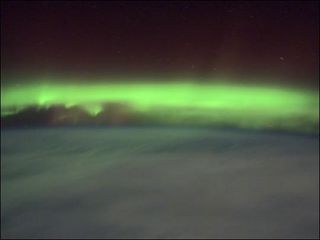
Probe Peers Into Energetic Edge of Earth's Atmosphere

As you move upward from Earth's surface and through the layers of its atmosphere, the air becomes thinner and thinner until you reach the diffuse boundary where the atmosphere meets the seeming void of outer space.
But the space surrounding Earth is anything but barren: It seethes with charged particles that flow around the planet's magnetic field, moving energy around, creating electric currents and producing the spectacular auroras that dance across polar skies.
Many of these particles stream in from the solar wind that blows out from the surface of the sun, but others come from the Earth's atmosphere itself. Unlike the hotter hydrogen coming from the sun, Earth's upper atmosphere generally supplies cooler oxygen ions that course outward along Earth's magnetic field lines.
This "ion outflow," as it is called, occurs continuously, but is especially strong during periods when there is more solar activity such as solar flares and coronal mass ejections that burst off the sun and move toward Earth. Such activity drives oxygen ions out of our planet's upper atmosphere, particularly in regions where aurora displays are strong. [Infographic: Earth's Atmosphere Top to Bottom]
"These ion outflow events are important because they help us understand the space weather environment around Earth," said Doug Rowland, the principal investigator for FASTSAT's Plasma Impedance Spectrum Analyzer (PISA), at NASA's Goddard Space Flight Center in Greenbelt, Md. "The heavy ions flowing away from Earth can act as a brake, or damper, on incoming energy from the solar wind. The flow also indicates ways in which planets can lose their atmospheres – something that happens slowly on Earth, but more quickly on smaller planets with weaker magnetic fields, like Mars."
Earlier this year, the NASA FASTSAT satellite mission got a detailed picture of this dynamic region and the particles swirling around it during a particularly well-defined event; the data gleaned from it are helping scientists better understand just what goes on there.
FASTSAT's Miniature Imager for Neutral Ionospheric Atoms and Magnetospheric Electrons (MINI-ME) instrument has been successfully spotting such outflows since the instrument first began to collect data in winter 2010. The instrument counts ions as it moves through a part of Earth's atmosphere called the ionosphere. This is the region where the particles gain enough speed and energy to overcome Earth's gravity, so it's an ideal place to study the first step in the outflow process.
Sign up for the Live Science daily newsletter now
Get the world’s most fascinating discoveries delivered straight to your inbox.
Late on March 31, 2011, the FASTSAT spacecraft flew through an ion outflow with well-defined areas of increased fast-moving, or "energetic," particles.

Simultaneous observations from PISA, which measures the density of material in the atmosphere, also showed that this was a highly structured auroral zone.
The FASTSAT data were compared to that from the Active Magnetosphere and Planetary Electrodynamics Response Experiment (AMPERE), a mission managed by the Johns Hopkins Applied Physics Laboratory, which measures current flow and magnetic features through a network of instruments placed on commercial satellites owned by Iridium Communications. AMPERE data showed current structures that were also consistent with what is expected for an auroral zone.
"This is just one event," said Michael Collier, principal investigator for MINI-ME also at NASA Goddard. "But it helps confirm the idea that the current and ion outflows are all connected. As we continue to go through the data, there will be many more events to follow," he explained. "We'd like to be able to pin down the origin of all these mechanisms in the ionosphere."

